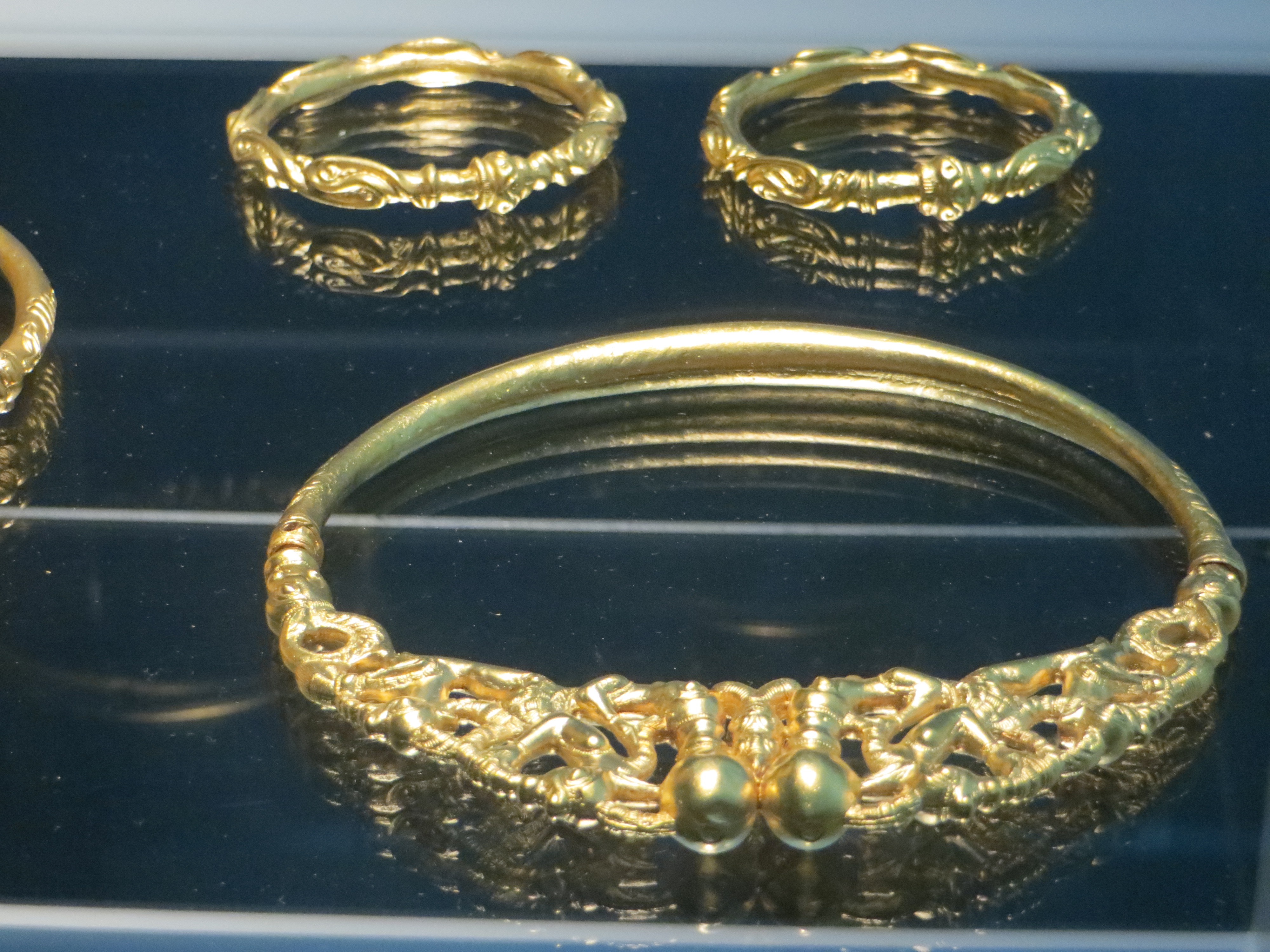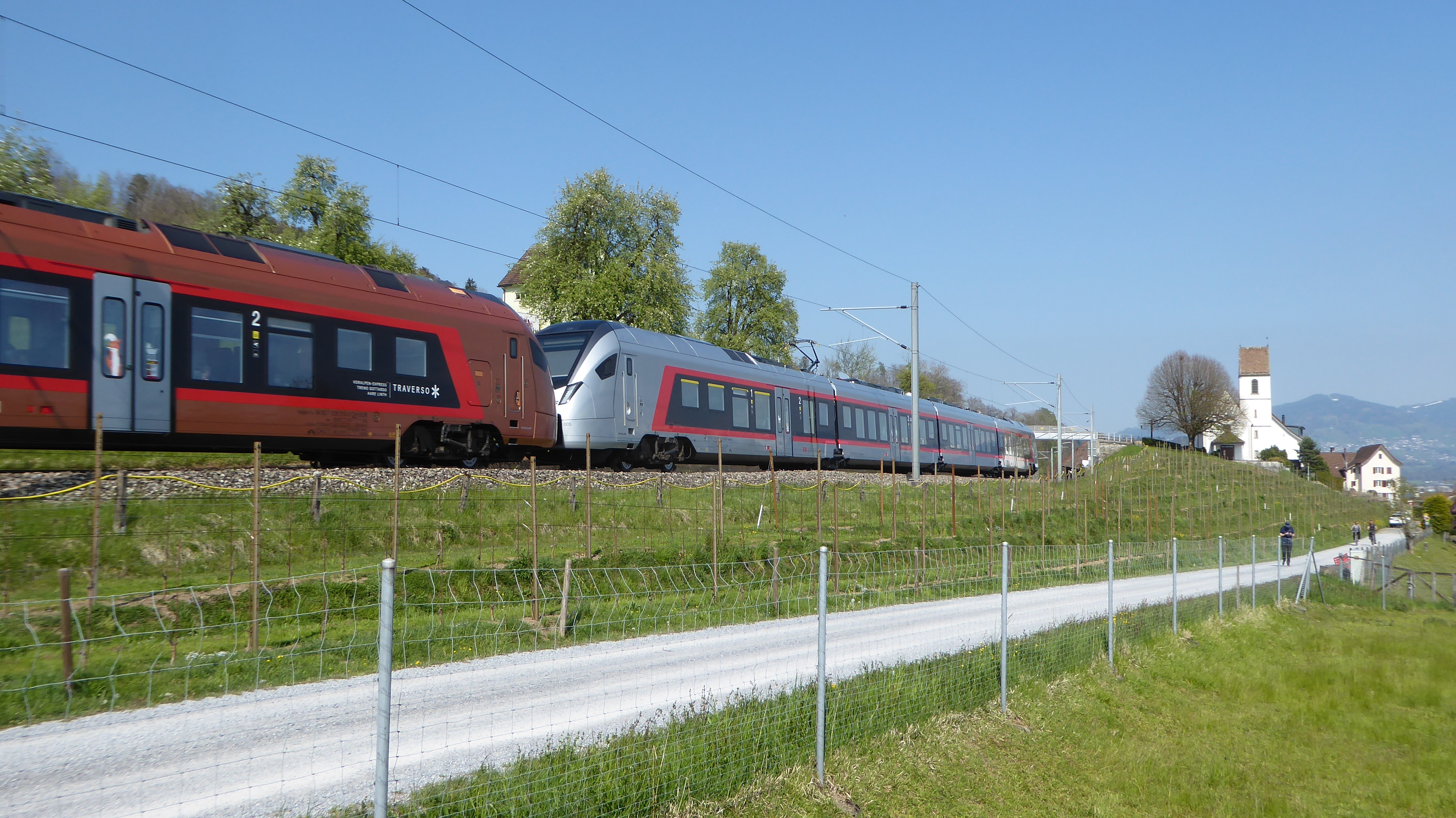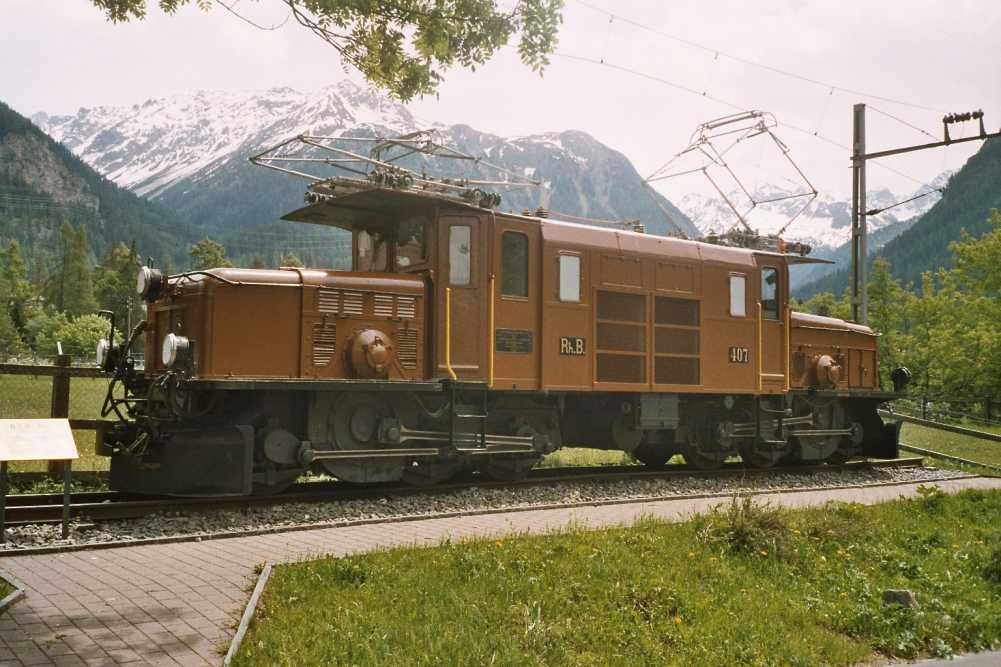|
Erstfeld Railway Station
Erstfeld railway station (german: Bahnhof Erstfeld) is a railway station in the Swiss canton of Uri and municipality of Erstfeld. The station is situated on the original line of the Gotthard railway, at the foot of the ramp up to the Gotthard Tunnel. The original line, and the newer line through the Gotthard Base Tunnel meet at a junction some north of, and downhill from, Erstfield station. Most trains on the Gotthard route now use the base tunnel and therefore do not pass through the station. A motive power depot at Erstfeld station houses rolling stock needed for the Gotthard route, and especially for banking service. A Ce 6/8 "crocodile" serves as a memorial for the legendary Gotthard locomotives. File:SBB Historic - F 122 00351 008 - Erstfeld Lokomotivdepot.jpg, Locomotive depot at Erstfeld (1998) Services the following services stop at Erstfeld: * InterRegio: hourly service between and ; trains continue to or Zürich Hauptbahnhof. * Zug Stadtbahn The Zug Stadtba ... [...More Info...] [...Related Items...] OR: [Wikipedia] [Google] [Baidu] |
Erstfeld
Erstfeld is a municipality in the canton of Uri in Switzerland. History In 1962 a collection of four gold torques and three gold arm rings were discovered near Erstfeld. While the exact origin date is unknown, they are likely from the 4th century BC. The nearly pure gold rings were discovered under of land slide debris. The rings show celtic motifs and designs and display a high level of skill. While their purpose is unknown, one theory is that they were offerings made to celebrate safely crossing the Alps. Erstfeld is first mentioned in 1258 as ''Ourzcvelt''. In 1638, it was listed under the Latin name ''in Protocampis''. In 1831, it was known as ''Hirschfelden''. Geography Erstfeld has an area, , of . Of this area, 11.7% is used for agricultural purposes, while 29.2% is forested. Of the rest of the land, 2.8% is settled (buildings or roads) and the remainder (56.2%) is non-productive (rivers, glaciers or mountains). , 19.8% of the total land area was heavily forested, whi ... [...More Info...] [...Related Items...] OR: [Wikipedia] [Google] [Baidu] |
Switzerland
). Swiss law does not designate a ''capital'' as such, but the federal parliament and government are installed in Bern, while other federal institutions, such as the federal courts, are in other cities (Bellinzona, Lausanne, Luzern, Neuchâtel, St. Gallen a.o.). , coordinates = , largest_city = Zürich , official_languages = , englishmotto = "One for all, all for one" , religion_year = 2020 , religion_ref = , religion = , demonym = , german: Schweizer/Schweizerin, french: Suisse/Suissesse, it, svizzero/svizzera or , rm, Svizzer/Svizra , government_type = Federalism, Federal assembly-independent Directorial system, directorial republic with elements of a direct democracy , leader_title1 = Federal Council (Switzerland), Federal Council , leader_name1 = , leader_title2 = , leader_name2 = Walter Thurnherr , legislature = Fe ... [...More Info...] [...Related Items...] OR: [Wikipedia] [Google] [Baidu] |
Swiss Federal Railways
Swiss Federal Railways (german: link=no, Schweizerische Bundesbahnen, ''SBB''; french: link=no, Chemins de fer fédéraux suisses, ''CFF''; it, Ferrovie federali svizzere, ''FFS'') is the national railway company of Switzerland. It is usually referred to by the initials of its German, French, and Italian names, either as SBB CFF FFS, or used separately. The Romansh version of its name, ''Viafiers federalas svizras'', is not officially used. The official English abbreviation is "SBB", instead of the English acronym such as "SFR", which stands for ''Swiss Federal Railways'' itself. The company, founded in 1902, is headquartered in Bern. It used to be a government institution, but since 1999 it has been a special stock corporation whose shares are held by the Swiss Confederation and the Swiss cantons. It is currently the largest rail and transport company of Switzerland, and operates on most standard gauge lines of the Swiss network. It also heavily collaborates with ... [...More Info...] [...Related Items...] OR: [Wikipedia] [Google] [Baidu] |
Gotthard Railway
The Gotthard railway (german: Gotthardbahn; it, Ferrovia del Gottardo) is the Swiss trans-alpine railway line from northern Switzerland to the canton of Ticino. The line forms a major part of an important international railway link between northern and southern Europe, especially on the Rotterdam-Basel-Genoa corridor. The Gotthard Railway Company (german: Gotthardbahn-Gesellschaft) was the former private railway company which financed the construction of, and originally operated, that line. The railway comprises an international main line through Switzerland from Basel (French Bâle) or Zürich to Immensee to Chiasso, together with branches, from Immensee to Lucerne and Rotkreuz, from Arth-Goldau to Zug, and from Bellinzona to Chiasso, via Locarno and Luino. The main line, second highest standard railway in Switzerland, penetrates the Alps by means of the Gotthard Tunnel at above sea level. The line then descends as far as Bellinzona, at above sea level, before climbing ... [...More Info...] [...Related Items...] OR: [Wikipedia] [Google] [Baidu] |
Südostbahn
The Südostbahn (German, literally meaning "South-Eastern Railway") – commonly abbreviated to SOB – is a Swiss adhesion railway company, and a network in Central and Eastern Switzerland. It resulted from the merger of the original SOB with the Bodensee–Toggenburg railway (BT) at the end of 2001. The Schweizerische Südostbahn AG (Swiss South-Eastern Railway SA) is a small private railway jointly owned by the cantonal and federal governments as an Aktiengesellschaft (AG). Network The rail network of the Südostbahn (SOB) consists of that formerly owned by BT in northeast Switzerland (between Lake Constance and Toggenburg): * Romanshorn– St. Gallen St. Fiden line, * St. Gallen–Herisau–Degersheim–Wattwil line, and * (Wattwil–)Ebnat-Kappel–Krummenau– Nesslau-Neu Sankt Johann line, and that previously owned by the original SOB located predominantly in Central Switzerland: * Rapperswil–Pfäffikon SZ line, * Pfäffikon S ... [...More Info...] [...Related Items...] OR: [Wikipedia] [Google] [Baidu] |
Canton Of Uri
The canton of Uri (german: Kanton Uri rm, Chantun Uri; french: Canton d'Uri; it, Canton Uri) is one of the 26 cantons of Switzerland and a founding member of the Swiss Confederation. It is located in Central Switzerland. The canton's territory covers the valley of the Reuss between the St. Gotthard Pass and Lake Lucerne. The official language of Uri is (the Swiss variety of Standard) German, but the main spoken dialect is the Alemannic Swiss German called . Uri was once the only canton whose children in school had to learn Italian as their first foreign language, but in the school year of 2005/2006, that was changed to English, as in other Central and Northeastern Swiss cantons. The canton's population is about 35,000, of which 3,046 (or 8.7%) are foreigners. The legendary William Tell is said to have hailed from Uri. The historical landmark Rütli lies within the canton of Uri. Name The name of the valley is first mentioned in the 8th or 9th century, in the Latinized f ... [...More Info...] [...Related Items...] OR: [Wikipedia] [Google] [Baidu] |
Gotthard Tunnel
, it, Galleria del San Gottardo , other_name = , line = Gotthard Line , location = Traversing the Saint-Gotthard Massif in the middle of the Swiss Alps , coordinates = , os_grid_ref = , status = , system = Swiss Federal Railways (SBB CFF FFS) , start = Göschenen, canton of Uri (north, ) , end = Airolo, canton of Ticino (south, ) , stations = , startwork = , opened = , closed = , rebuilt = , reopen = , owner = SBB CFF FFS , operator = SBB Infrastructure , traffic = railway , character = passenger, freight , engineer = Louis Favre , construction = , length = , linelength = , tracklength = , notrack = Double , gauge = (standard gauge) , el = 15 kV 16.7 Hz since , speed = , hielevation = (inside the tunnel) , lowelevation = (north portal) , height ... [...More Info...] [...Related Items...] OR: [Wikipedia] [Google] [Baidu] |
Gotthard Base Tunnel
, rm, Tunnel da basa dal Sogn Gottard , image = 20141120 gotthard-basistunnel02-wikipedia-hannes-ortlieb.jpg , image_size = 250 , caption = Turnout at Faido multifunction station , line = Gotthard Line , location = Switzerland (Uri, Grisons and Ticino) , coordinates = , system = Swiss Federal Railways (SBB CFF FFS) , status = Active since 11 December 2016 , crosses = Alps (western Glarus Alps and central Lepontine Alps at the eastern Gotthard Massif) , start = Erstfeld, canton of Uri (north, ) , end = Bodio, canton of Ticino (south, ) , stations = , startwork = 4 November 1999 , opened = 1 June 2016 , closed = , owner = SBB Infrastructure , operator = SBB CFF FFS , traffic = Railway , character = Passenger and freight , length = , linelength = , tracklength = , notrack = 2 single-track tubes , gauge = (standard gauge) , el = 15 kV 16.7 Hz , speed = , hielevation = , lowelevation = (south portal) , height = from top of rail to overhead conductor , ... [...More Info...] [...Related Items...] OR: [Wikipedia] [Google] [Baidu] |
Motive Power Depot
The motive power depot (MPD) or locomotive depot, or traction maintenance depot (TMD), is the place where locomotives are usually housed, repaired and maintained when not being used. They were originally known as "running sheds", "engine sheds" or, for short, just sheds. Facilities are provided for refuelling and replenishing water, lubricating oil and grease and, for steam engines, disposal of the ash. There are often workshops for day to day repairs and maintenance, although locomotive building and major overhauls are usually carried out in the locomotive works. (Note: In American English, the term ''depot'' is used to refer to passenger stations or goods (freight) facilities and not to vehicle maintenance facilities.) German practice The equivalent of such depots in German-speaking countries is the ''Bahnbetriebswerk'' or ''Bw'' which has similar functions, with major repairs and overhauls being carried out at ''Ausbesserungswerke''. The number of these reduced drastic ... [...More Info...] [...Related Items...] OR: [Wikipedia] [Google] [Baidu] |
Bank Engine
A bank engine (United Kingdom/Australia) (colloquially a banker), banking engine, helper engine or pusher engine (North America) is a railway locomotive that temporarily assists a train that requires additional power or traction to climb a gradient (or ''bank''). Helpers/bankers are most commonly found in mountain divisions (called "helper districts" in the United States), where the ruling grade may demand the use of substantially greater motive power than that required for other grades within the division. Historic practice Helpers/bankers were most widely used during the age of steam, especially in the American West, where significant grades are common and trains are long. The development of advanced braking systems and diesel-electric or electric locomotives has eliminated the everyday need for bankers/helpers in all but a few locations. With the advent of dynamic brakes on electric or diesel-electric locomotives, helpers/bankers can also be used to provide more braking fo ... [...More Info...] [...Related Items...] OR: [Wikipedia] [Google] [Baidu] |
Crocodile (locomotive)
Crocodile (German ''Krokodil'') electric locomotives are so called because they have long "noses" at each end, reminiscent of the snout of a crocodile (see also Steeplecab). These contain the motors and drive axles, and are connected by an articulated center section. The center section usually contains the crew compartments, pantographs and transformer. The name was first applied to Swiss locomotives. Sometimes the term is applied to locomotives in other countries of a similar design. History Switzerland Class Ce 6/8 A prototype locomotive, SBB-CFF-FFS Ce 6/8 I number 14201, was ordered in June 1917. The production "Crocodiles" were the series ''SBB Ce 6/8 II'' and ''SBB Ce 6/8 III'' locomotives of the SBB, Swiss Federal Railways, built between 1919 and 1927. There were 33 class Ce 6/8 II and 18 class Ce 6/8 III, making a total (excluding the prototype) of 51 locomotives. These locomotives were developed for pulling heavy goods trains on the steep tracks of the Gotthar ... [...More Info...] [...Related Items...] OR: [Wikipedia] [Google] [Baidu] |









